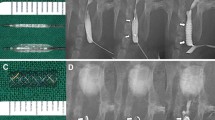Abstract
Purpose
This study was designed to clarify the advantages of biodegradable stents in terms of mucosal reaction and biodegradation after placement. We designed a biodegradable stent and assessed stent degradation and changes in the normal bile ducts of dogs.
Methods
The biodegradable stent is a balloon-expandable Z stent consisting of poly-l-lactic acid (PLLA) with a diameter of 6 mm and a length of 15 mm. We assessed four groups of three beagle dogs each at 1, 3, 6, and 9 months of follow-up. After evaluating stent migration by radiography and stent and bile duct patency by cholangiography, the dogs were sacrificed to remove the bile duct together with the stent. The bile duct lumen was examined macroscopically and histologically, and the stent degradation was examined macroscopically and by scanning electron microscopy (SEM).
Results
Bile duct obstruction was absent and none of the stents migrated. Macroscopic evaluation showed moderate endothelial proliferation in the bile ducts at the implant sites at 3 and 6 months and a slight change at 9 months. Slight mononuclear cell infiltration was histologically identified at all time points and epithelial hyperplasia that was moderate at 3 months was reduced to slight at 6 and 9 months. Stent degradation was macroscopically evident in all animals at 9 months and was proven by SEM in two dogs at 6 months and in all of them at 9 months.
Conclusions
Our results suggest that PLLA bioabsorbable stents seems to be useful for implantation in the biliary system with further investigation.







Similar content being viewed by others
References
Ginsberg G, Cope C, Shah J et al (2003) In vivo evaluation of a new bioabsorbable self-expanding biliary stent. Gastrointest Endosc 58(5):777–784
Yoshioka T, Sakaguchi H, Yoshimura H et al (1990) Expandable metallic biliary endoprostheses: preliminary clinical evaluation. Radiology 177(1):253–257
Tamai H, Igaki K, Kyo E et al (2000) Initial and 6-month results of biodegradable poly-l-lactic acid coronary stents in humans. Circulation 102(4):399–404
Lumiaho J, Heino A, Pietiläinen T et al (2000) The morphological, in situ effects of a self-reinforced bioabsorbable polylactide ureteric stent: an experimental study. J Urol 164(4):1360–1363
Talja M, Multanen M, Välimaa T et al (2002) Bioabsorbable SR-PLGA horn stent after antegrade endopyelotomy: a case report. J Endourol 16(5):299–302
Laaksovirta S, Talja M, Välimaa T et al (2001) Expansion and bioabsorption of the self-reinforced lactic and glycolic acid copolymer prostatic spiral stent. J Urol 166(3):919–922
Unverdorben M, Spielberger A, Schywalsky M et al (2002) A polyhydroxybutyrate biodegradable stent: preliminary experience in the rabbit. Cardiovasc Intervent Radiol 25(2):127–132
Multanen M, Talja M, Tammela TL et al (2001) Biocompatibility of silver nitrate and ofloxacine coated bioabsorbable SR-PLLA rods. Urol Res 29(2):113–117
Saito Y, Minami K, Kobayashi M et al (2002) New tubular bioabsorbable knitted airway stent: biocompatibility and mechanical strength. J Thorac Cardiovasc Surg 123(1):161–167
Korpela A, Aarnio P, Sariola H et al (1998) Comparison of tissue reactions in the tracheal mucosa surrounding a bioabsorbable and silicone airway stents. Ann Thorac Surg 66(5):1772–1776
Born P, Rösch T, Brühl K et al (1999) Long-term results of endoscopic and percutaneous transhepatic treatment of benign biliary strictures. Endoscopy 31(9):725–731
Talja M, Multanen M, Välimaa T et al (2002) Bioabsorbable SR-PLGA horn stent after antegrade endopyelotomy: a case report. J Endourol 16(5):299–302
Isotalo T, Alarakkola E, Talja M et al (1999) Biocompatibility testing of a new bioabsorbable x-ray positive SR-PLA 96/4 urethral stent. J Urol 162(5):1764–1767
Isotalo T, Talja M, Välimaa T et al (2002) A bioabsorbable self expandable, self reinforced poly L lactic acid urethral stent for recurrent urethral strictures long term results. J Endourol 16(10):759–762
Conflict of interest
The authors declare that they have no conflict of interest.
Author information
Authors and Affiliations
Corresponding author
Rights and permissions
About this article
Cite this article
Yamamoto, K., Yoshioka, T., Furuichi, K. et al. Experimental Study of Poly-l-Lactic Acid Biodegradable Stents in Normal Canine Bile Ducts. Cardiovasc Intervent Radiol 34, 601–608 (2011). https://doi.org/10.1007/s00270-010-0045-2
Received:
Accepted:
Published:
Issue Date:
DOI: https://doi.org/10.1007/s00270-010-0045-2




